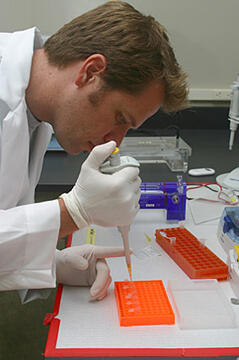Molecular Species Identification
Dr. Amy Vandergast and team develop genetic approaches for species detection, individual mark recapture, and studying ecological associations (such as predator/prey relationships). These techniques often increase monitoring effectiveness and efficiency when replacing or combining with standard field methodologies.

Sometimes even fundamental information, like whether a species is present or absent at a site, can be challenging to obtain when species are rare and difficult to find. It is becoming increasingly common to use genetic techniques along with more traditional field sampling, to determine species presence from environmental samples (eDNA). We also conduct genetic analysis of fecal samples to assess diet in managed species. Recent growth in technical sequencing capabilities have greatly improved the ability to identify entire communities in a single environmental sample, and in many cases can increase effectiveness and efficiency over more standard field techniques and microscopy. Moreover, because these methods rely on environmental samples or scat, they can be much less invasive and disruptive. Complexity and challenges exist in developing specific assays and relevant databases of local fauna and in verifying methodologies in both laboratory controls and field settings.
Back to Species Management
Dr. Amy Vandergast and team develop genetic approaches for species detection, individual mark recapture, and studying ecological associations (such as predator/prey relationships). These techniques often increase monitoring effectiveness and efficiency when replacing or combining with standard field methodologies.

Sometimes even fundamental information, like whether a species is present or absent at a site, can be challenging to obtain when species are rare and difficult to find. It is becoming increasingly common to use genetic techniques along with more traditional field sampling, to determine species presence from environmental samples (eDNA). We also conduct genetic analysis of fecal samples to assess diet in managed species. Recent growth in technical sequencing capabilities have greatly improved the ability to identify entire communities in a single environmental sample, and in many cases can increase effectiveness and efficiency over more standard field techniques and microscopy. Moreover, because these methods rely on environmental samples or scat, they can be much less invasive and disruptive. Complexity and challenges exist in developing specific assays and relevant databases of local fauna and in verifying methodologies in both laboratory controls and field settings.
Back to Species Management

